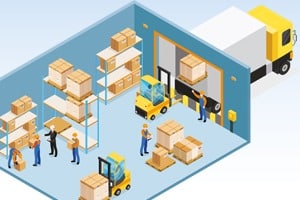What is a merchandise management system?
Merchandise management system: definition, tasks and functions at a glance
Optimally aligned processes within a company are considered a key success factor. This relates in particular to the flow of goods, which requires smooth logistics and scheduling. Such processes can be mapped and optimized with the help of a merchandise management system.
Definition of merchandise management system: IT-supported coordination of all merchandise management and order processing tasks
A system that integrates all sub-areas and makes them centrally controllable is needed to ensure that all intermediate steps can be carried out quickly from order receipt. After all, it’s not just goods that leave the warehouse, returns also have to be taken into account. In addition, various sales channels (online store, direct sales, stationary retail, etc.) need to be considered.
In short, a merchandise management system helps to keep track of the location or whereabouts of a product at all times. Once integrated into the system, all goods movements are documented. Depending on its scope and compatibility, especially through interfaces, a merchandise management system supports various organizational and logistical processes in the company.
The use of such a system also allows statistics and other data to be evaluated, which form the basis for decisions on operational matters.
Organization and structure: How merchandise management system is structured
As there are many different merchandise management systems, some of which are more like ERP systems due to their range of functions, it is important to differentiate between them. As a rule, a merchandise management system offers the following basic modules with corresponding functions:
Incoming goods, outgoing goods, warehousing
All processes relating to delivery, goods receipt and inspection as well as invoice verification can be found here. Downstream are order processing including order picking and dispatch processing including outgoing goods inspection.
Purchasing, Sales
All tasks relating to offer management, scheduling and complaints in relation to purchasing are managed here. Downstream are customer data management, salesperson management, action planning and any returns.
Master data maintenance
As part of logistics planning, it is important to have central information on each of the goods and thus make optimum use of storage space. This data can not only be transferred to individual sales channels, but can also be used for order picking.
Returns and inventory
Knowing exactly what is available, where and in what quantity is crucial. By documenting the flow of goods and making the whereabouts of individual goods transparent, an inventory management system provides important information for decision-making.
Statistics
Optimizing the flow of goods is important in order to minimize costs, better reflect customer wishes and maintain a holistic product range.
CRM and controlling interfaces
The degree of functionality of an merchandise management system is determined not least by the interfaces that are available. This makes it easy to exchange data and keep it up to date, which enables real-time evaluations and thus offers planning reliability.
Advantages of using a merchandise management system
By mapping all important processes digitally and uniformly in a merchandise management system, companies can make better decisions. Thanks to the connection to a warehouse management system, separately managed processes can still be brought together centrally. In this case, the warehouse management system is used for inventory management and other warehouse tasks, such as picking orders.
The customer orders, goods movement data or invoices recorded in the MRP are then exchanged or compared. This creates a complete, up-to-date picture for optimum order processing and merchandise management.
An overview of other advantages of a merchandise management system:
- Time savings through centralized access to warehouse and product data to create quotes, invoices, etc.
- Uniform, centralized data management without disruptions
- Maximum transparency by mapping all important sub-areas
- Integration of several storage areas
- Linking with CRM systems possible
Also important: A closed merchandise management system covers all business management tasks, whereas an open merchandise management system is characterized by the integration of individual functional areas (purchasing, sales, production, warehouse). A third form is represented by integrated merchandise management systems that include all modules and also offer interfaces for external parties.
